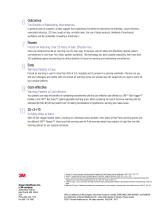 Website:
3M Health Care
Website:
3M Health Care
Group: 3M
Catalog excerpts

To Warm Every Surgical Patient Patients Undergoing General Anesthesia are Susceptible to Inadvertent Perioperative Hypothermia (IPH). All surgical patients—regardless of age, weight or other factors—undergoing general anesthesia are susceptible to Redistribution Temperature Drop (RTD). Research shows that core body temperature drops up to 1.6°C in the first hour following the induction of general anesthesia,1 increasing the risk for inadvertent perioperative hypothermia and its associated complications, which include higher mortality rates,2 longer hospital stays3 and an increased rate of wound infection.4 Inadvertent Perioperative Hypothermia and Its Complications Can Be Easily Prevented. Stop inadvertent perioperative hypothermia before it begins by prewarming your patients prior to surgery. Just 15 minutes of actively prewarming with forced-air warming can add to the body’s total heat content and combat RTD. By preventing inadvertent hypothermia hypothermia, you could help your patients avoid the complications associated with it, including an increased rate of wound infection.4 For additional information, visit www.preventhypothermia.org. National Quality Improvement Initiatives Recommend Normothermia Maintenance to Reduce SSIs. Institute for Healthcare Improvement and Surgical Care Improvement Project initiatives note the importance of maintaining normothermia to help reduce the incidence of surgical site infections in surgical patients. These initiatives also recommend the use of forced-air warming as an active warming measure to maintain normothermia. For more information, visit www.ihi.org or www.qualitynet.org. Normothermia for Improving Surgical Care. An anesthesia quality measure adopted by the Centers for Medicare and Medicaid Services calls for normothermia to be achieved for a broad range of surgical patients. All patients undergoing general or neuraxial anesthesia for procedures 60 minutes or longer are to reach a target temperature of 36°C as measured in the operating room or PACU. If for some reason normothermia is not achieved, the measure also can be met by showing that proven active warming measures were used. Patients Remember Being Cold. Patients probably won’t remember the antibiotics administered to help prevent SSIs, but they will remember feeling cold before and after surgery. Using forced-air warming throughout the perioperative period can increase patient satisfaction, decrease patient anxiety and contribute to SSI reduction e
Open the catalog to page 1
The Benefits of Maintaining Normothermia. In general types of surgeries, studies suggest that maintaining normothermia decreases the following: wound infection, myocardial infarction, ICU time, length of stay, mortality rates, the use of blood products, likelihood of mechanical ventilation and the probability of needing a transfusion.5 Forced-Air Warming: Over 25 Years of Safe, Effective Use. Since we introduced forced-air warming over 25 years ago, it has been used to safely and effectively maintain patient normothermia in more than 165 million patients worldwide. This technology has been...
Open the catalog to page 2All 3M Health Care catalogs and technical brochures
-
The Importance of Fit
1 Pages
-
OrthodonticProduc
236 Pages
-
Clarity
12 Pages
-
RelyX Ultimate
2 Pages
-
paradigm™
4 Pages











